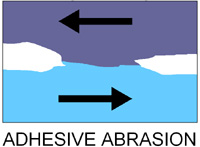Types of Wear
The type of relative motion is often used to define the wear that is generated. Because of its complexity, a number of wear modes have been recognized.
Abrasive wear – Wear due to hard particles or hard protuberances forced against and moving along a solid surface. These hard particles might be commercial abrasives like silicon carbide and aluminum oxide, or naturally occurring contaminates like dust particles and sand [crystalline silica (quartz)]. If the abrasive particles are allowed to roll, rolling abrasion or three-body abrasion occurs.
Adhesive wear – Wear due to localized bonding between contacting solid surfaces leading to material transfer between the two surfaces or loss from either surface. Adhesive wear is not as prevalent as abrasive wear and is induced when like materials slide against each other with no lubrication. This type of wear involves the formation of local cold welds between surfaces contacting under a load and tangential shearing or plowing of the junctions. Material can be transferred from one surface to the other during this process.
Catastrophic wear – Rapidly occurring or accelerating surface damage, deterioration, or change of shape caused by wear to such a degree that the service life of a part is appreciably shortened or its function is destroyed.
Corrosive wear – Wear in which chemical or electrochemical reaction with the environment is significant.
Crocking – A transfer of color from the surface of a colored fabric to an adjacent area of the same fabric, or to another surface principally by rubbing action.
Cutting wear – In solid impingement erosion, the erosive wear associated with the dissipation of kinetic energy of impact arising from the tangential component of the velocity of the impacting particles
Deformation wear – In solid impingement erosion, the erosive wear of a material associated with the dissipation of kinetic energy of impact arising from the normal component of the velocity of the impacting particles. It is therefore the sole component of wear for particles impacting at a 90-degree angle of attack.
Erosion - Damage caused by particulate in gases or liquids striking a surface.
Erosive wear – Progressive loss of original material from a solid surface due to mechanical interaction between that surface and a fluid, multi-component fluid, or impinging liquid or solid particles.
Fatigue wear – Wear of a solid surface caused by fracture arising from material fatigue.
Fretting wear – Wear arising as a result of fretting [where fretting, in tribology, involves a small amplitude oscillatory motion, usually tangential, between two solid surfaces in contact].
Frosting – A change in color in a limited area of fabric caused by abrasive wear.
Impact wear – Wear due to collisions between two solid bodies where some component of the motion is perpendicular to the tangential plane of contact.
Mar abrasion – Permanent deformations that have not ruptured the surface of a coating, but tend to disfigure or change the appearance of its surface.
Pitting – A form of wear characterized by the presence of surface cavities, the formation of which is attributed to processes such as fatigue, local adhesion, or cavitations.
Rolling wear – Wear due to the relative motion between two non-conforming solid bodies whose surface velocities in the nominal contact location are identical in magnitude, direction and sense.
Rolling abrasion – A form of abrasion that occurs when abrasive particles or debris are allowed to “roll” between the surface and a contacting substance (also see three-body wear).
Scoring – A severe form of wearing characterized by the formation of extensive grooves and scratches in the direction of sliding.
Scratching – The mechanical removal or displacement, or both, of materials from a surface by the action of abrasive particles or protuberances sliding across the surfaces. Typically in the form of a line, caused by the relative movement of an object across and in contact with the surface.
Scuffing – A form of wear occurring in inadequately lubricated tribo-systems that is characterized by macroscopically observed changes in surface texture with features related to the direction of relative motion.
Sliding wear – Wear due to the relative motion in the tangential plane of contact between two solid bodies. Typically recognized by linear grooves that are generated from a reciprocating or unidirectional contact.
Three-body wear – A form of abrasive wear in which wear is produced by loose particles introduced or generated between the contacting surfaces.
Two-body abrasive wear – A form of abrasive wear in which the hard particles or protuberances that produce the wear of one body are fixed on the surface of the opposing body.
Wear – Damage to a solid surface, generally involving progressive loss of material, due to relative motion between that surface and a contacting substance or substances.
sources: ASTM International, G40 – Terminology Wear & Erosion
ASTM International D123 – Terminology Textiles


